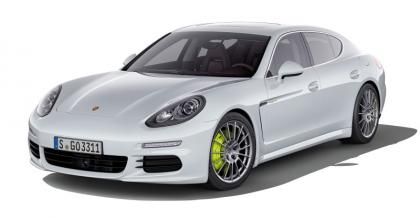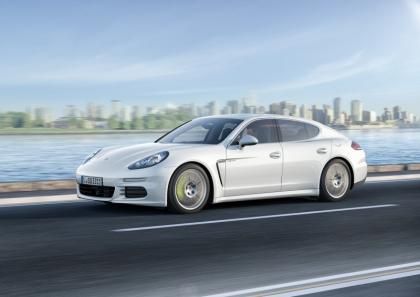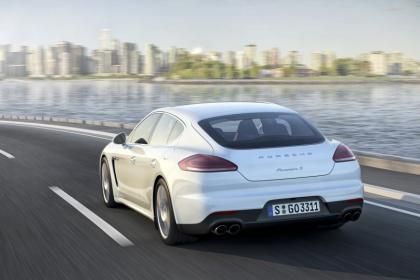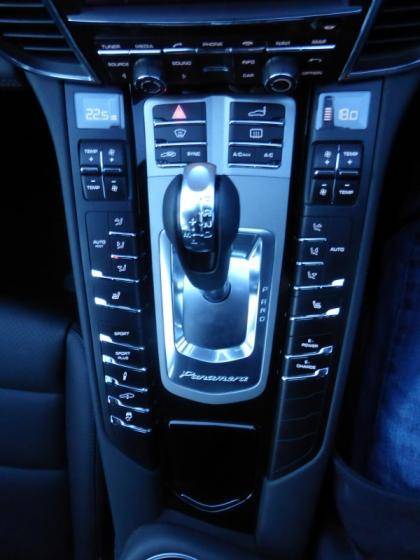For us, the 2013 Panamera S E-Hybrid is something of a conundrum. The S E-Hybrid is an £89,000 luxury car that’ll sprint from zero to 62mph in 5.5 seconds, yet it also has a claimed fuel economy of 91mpg. We’d never expect to get the claimed fuel economy, and certainly not if we’re reaching 62mph in 5.5 seconds from a standing start. Even so, a luxury sports car that provides something close to that claimed fuel economy when you’re not tearing down country lanes would be truly phenomenal.

The Panamera S E-Hybrid is certainly powerful. It has a front-mounted supercharged 3-litre V6 engine that drives the rear wheels, along with a 95hp electric motor. The electric motor can either power the car alone or it can be used in conjunction with the combustion engine to produce a whopping 416hp at 5,500rpm and 590Nm of torque between 1,250rpm and 4,000rpm.
You can keep the Lithium-ion battery charged with electricity from household electrical mains or a commercial charging station. Conveniently, you can also use the combustion engine to charge the battery.
Porsche puts the S E-Hybrid’s electric range between 11 and 22 miles depending on factors such as driving style and speed, and while that might not match the high ranges of solely electric cars such as the Renault Zoe , which has a claimed range of 62 to 93 miles, the S E-Hybrid’s range might be enough to get to the office and back, or nip to the local retail park. Given the relatively short distances involved in many journeys, such as picking up a loved one from their workplace or a train station, it’s possible that you could restrict use of the combustion engine to long journeys, or when you want to put the sports pedigree of the S E-Hybrid to the test.

ELECTRIC PERFORMANCE
The Panamera S E-Hybrid performs differently depending on the drive mode you’re using. By default, the S E-Hybrid always starts in E-Power mode, which means only the electric motor is driving the wheels.
This seems the most sensible option, especially if you want to conserve fuel, yet it has the side effect of making ‘ignition’ worryingly silent. Turn the key and nothing happens except for the slight rise of a needle on the instrument panel. There’s no cacophonic roar from the exhaust, not even a burble, just an eerie silence that makes you wonder if it’s started at all.
The performance of the Panamera S E-Hybrid’s electric motor is astounding when you consider that this car weighs 2.1 tonnes. It takes up to two seconds for the car to move when you press the accelerator pedal, but then the S E-Hybrid moves off and accelerates at a rate you wouldn’t expect for an electric vehicle of this weight. We had no trouble accelerating to 30mph, and certainly no trouble keeping up with traffic. Our test routes took us through town centres and villages with a healthy amount of inclines and declines, and the S E-Hybrid handled them all well. Throughout our tests the Panamera performed like a fairly powerful supermini, except quietly.
The Panamera S E-Hybrid also exceeded our expectations when we took it on a dual carriageway. Unsure how the S E-Hybrid would perform, we dutifully tucked in behind someone else at the lights, yet we soon found ourselves overtaking other cars and were lining up in the outside lane at the next red. We’d hoped to keep up with traffic, but we didn’t expect to be able to overtake it so easily. Porsche claims a top speed of 83mph when running on the battery, and while we didn’t put that claim to the test we certainly had no trouble cruising between 60 and 70mph.

BEST OF BOTH
Although the car starts in E-Power mode, you can switch out of it any time. When not in E-Power or Sport modes, the S E-Hybrid’s electric motor and combustion engine work in tandem to provide either efficient fuel economy or sports car power, depending on driving style. This mode will suit most drivers best when commuting or cruising on the motorway. As long as there’s enough charge in the battery, the S E-Hybrid runs on the electric motor unless you press the accelerator pedal hard, at which point the combustion engine kicks in and delivers greater propulsion. This system works well and, remarkably, is mostly transparent to the driver.
If you’ve ever driven a car with an idle-stop feature, you’re probably aware of the sudden silence that descends when it engages, and the cough and engine noise that disturbs the peace when you set off again. You’d expect something similar from the S E-Hybrid when the combustion engine kicks in, but there’s none of that. There’s no cough from the starter motor, no shudder caused by a starting engine, just a faint noise from the exhaust and a tranquillity commensurate with a luxury car.
To ensure you’re driving at your most efficient, Porsche has placed a special power meter in the instrument panel that shows when the S E-Hybrid is recuperating energy and how much power it’s producing as a percentage. The first 30 per cent of the meter is coloured green, and that’s the zone in which the S E-Hybrid is most efficient. If you’re driving around town or on the motorway there’s little reason to demand more power, unless you want to escape from a junction quickly or need to overtake, and keeping within the green zone is easy.
In regular hybrid mode, the car’s setup and performance is geared more towards comfort than high performance and speed. There’s plenty of shove from the supercharged engine when you need it, which makes for painless overtaking, but you can’t escape the feeling that the S E-Hybrid is constrained. If you want to experience the S E-Hybrid at its full potential you’ll need to hit the Sport button.
Sport mode makes the throttle more lively and responsive, and stiffens the suspension. The S E-Hybrid is a heavy car, so although there’s plenty of power on tap, and acceleration is very quick, you’re not thrown back in your seat when your stamp your right foot. Even so, it provides the thrilling drive you expect of a Porsche.

TIPTRONIC BOX
The Panamera S E-Hybrid uses the eight-speed Tiptronic gearbox rather than the seven-speed, dual-clutch PDK gearbox. We understand the intuition behind this decision, the assumption being that owners of the Diesel and S E-Hybrid models are more like likely to drive more efficiently and won’t want to change gears in a hurry. We also agree with the decision to a large extent, but having used the PDK gearbox in other Porsche models we can’t help but miss it.
